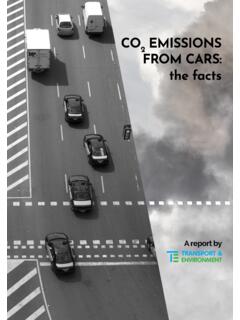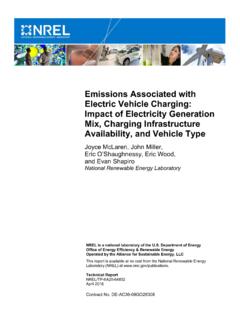Transcription of Comparison of hydrogen and battery electric trucks
1 1 Comparison of hydrogen and battery electric trucks methodology and underlying assumptions June 2020 2 1. Vehicle characteristics The sample vehicle for both the regional delivery and long-haul duty cycle is a typical tractor-trailer under type-approval in the European Union. It has a gross combined vehicle weight (GCVW) of 40 tonnes, a vehicle curb weight of 14 tonnes and a resulting maximum payload of 26 tonnes. Both the fuel cell electric (FCEV) as well as the battery electric vehicle (BEV) have an electric drivetrain with a combined rated power output of 350 kW.
2 The FCEV features a fuel cell stack, compressed hydrogen storage tank and a smaller onboard battery pack to buffer for engine peak loads. The BEV has a large onboard battery pack whose usable capacity is capped at 80% to ensure long-term durability. The main criterion for determining the onboard energy storage for the FCEV and BEV is that the respective vehicle reaches the required operational range without the need for refuelling or recharging in between. 3 The energy consumption values are based on Earl et They take into account vehicle efficiency improvements due to reduced rolling resistance and aerodynamic drag on a 40-tonnes tractor-trailer cruising at EU-specific highway speeds of 80 km/h (50 mph) and represent a reasonable mean value between industry announcements and various literature sources.
3 Moultak et al. and Sharpe estimate an approximate energy demand at the wheels of kWh/km in 2020 and kWh/km in 2030 at a highway speed of 65 mph (105 km/h).2 , 3 Tesla has announced an energy consumption of its Semi truck of less than kWh/km (also at 65 mph).4 The energy demand at the wheels is identical for both the FCEV and BEV as they share the same vehicle characteristics and drivetrain components. The efficiency differences between them is solely due to the additional conversion loss when converting the hydrogen in the fuel cell to electricity (54% conversion efficiency rate in 2020 and 56% in 2030).
4 5 Parameters Regional delivery Long-haul FCEV BEV FCEV BEV 2020 2030 2020 2030 2030 Annual mileage 80,000 km 120,000 km Energy consumption at the wheels in kWh/kmi Max. range without refuelling / recharging 400 km 1,200 km 800 km H2 fuel tank size (compressed at 700 bar) 30 kg H2 23 kg H2 - 70 kg H2 - battery size (usable capacity capped at 80%) 70 kWh 720 kWh 575 kWh 70 kWh 1,150 kWh i Energy consumption at the wheels determines the onboard energy storage capacity which is required to reach the max.
5 Range without refuelling / recharging. To calculate the electricity consumption ( fuel costs) of the BEV, additional charging losses need to be taken into account. The respective energy consumption values measured from the grid are (2020) and (2030). 4 2. Duty cycles The regional delivery duty cycle is characterised by single trip lengths of up to 400 km and the vehicle's return to the depot overnight which is located outside of urban areas. 62% of EU truck activity measured (in tonne-kilometres) comprises trips of less than 400 The average annual mileage is set at 80,000 km based on the European The long-haul duty cycle involves multi-day intercity travel with maximum daily trip lengths of up to 800 km if the vehicle is equipped with one driver.
6 The trip length is aligned with EU rules on driving times and rest periods which foresee maximum daily driving periods of 9 hours (which can go up to 10 hours).8 At an 80 km/h average vehicle speed, this amounts to 800 km per day. 78% of EU truck activity comprises trips of less than 800 km. The average annual mileage is set at 120,000 km also based on the European 3. Total cost of ownership The total cost of ownership (TCO) comprises all vehicle costs, fuel costs, infrastructure costs as well as all taxes, levies and road charges as they would occur if the vehicle was owned and operated in France.
7 The taxation schemes are somewhat different among the EU Member States and France represents a good proxy among them in terms of tax and excise duty rates. In a broader sense, the TCO describes the total expenses for a haulier. The TCO comprises nominal prices for a first vehicle use period of 5 years (including the vehicle's residual value and excluding VAT and financing costs). Vehicle costs The vehicle costs are based on K hnel et al. (except for battery costs) which undertook a bottom-up cost estimation for the different vehicle components and included a mark-up factor of to determine the net retail price after manufacturing and distribution The cost assumptions are based on the German cost level.
8 Since the price level and purchase power in the two countries are broadly similar, the costs should be comparable. The total net retail price (excl. VAT and financing costs) include the applicable costs due to the vehicle glider, electric motor, inverter, gearbox, fuel cell stack, hydrogen storage tank and battery pack. Maintenance and repair costs refer to costs due to general servicing over the first use period. The taxes on vehicle purchase and operation include the French-specific one-time registration tax and additional parafiscal charge as well as the annual special tax on certain motor 5 Vehicle costs Regional delivery Long-haul 2020 2030 2030 BEV Retail price 215,795 122,432 167,274 Maintenance & repairs 8,400 8,400 12,600 Vehicle taxes 573 573 573 FCEV Retail price 159,956 114,651 138,958 Maintenance & repairs 15,400 10,960 16.
9 440 Vehicle taxes 573 573 573 The battery pack costs are based on BloombergNEF and include the same mark-up factor of as for the vehicle costs to determine the pack's retail price after manufacturing and distribution The battery pack density values are the low assumptions on the potential for future technological improvement taken by Ricardo Energy & battery pack costs 2020 2030 Net costs per kWh 135 56 Retail costs per kWh 188 78 Energy density ( battery pack level) 183 Wh/kg 318 Wh/kg Renewable electricity and fuel costs It should be noted that both the FCEV and BEV are fuelled with renewable hydrogen and renewable electricity respectively.
10 This has been a deliberate choice in order to provide for a level playing field and compare two technologies which can ensure zero well-to-wheel GHG emissions (though not lifecycle 6 GHG emissions). Depending on the electricity or fuel origin and production method, the TCO and the moment of cost parity with diesel can vary significantly (see also section below). The Agora PtG/PtL calculator was used to calculate the levelised cost of electricity (LCOE) and the levelised cost of hydrogen (LCOH) produced from additional renewable electricity The electricity generation and fuel production facilities are either based in the North Sea or in North Africa.















